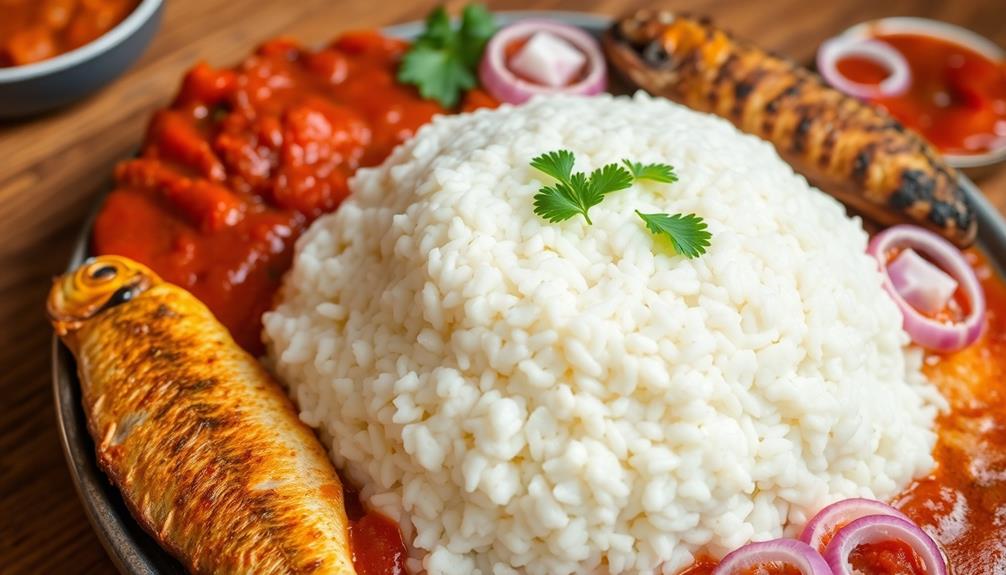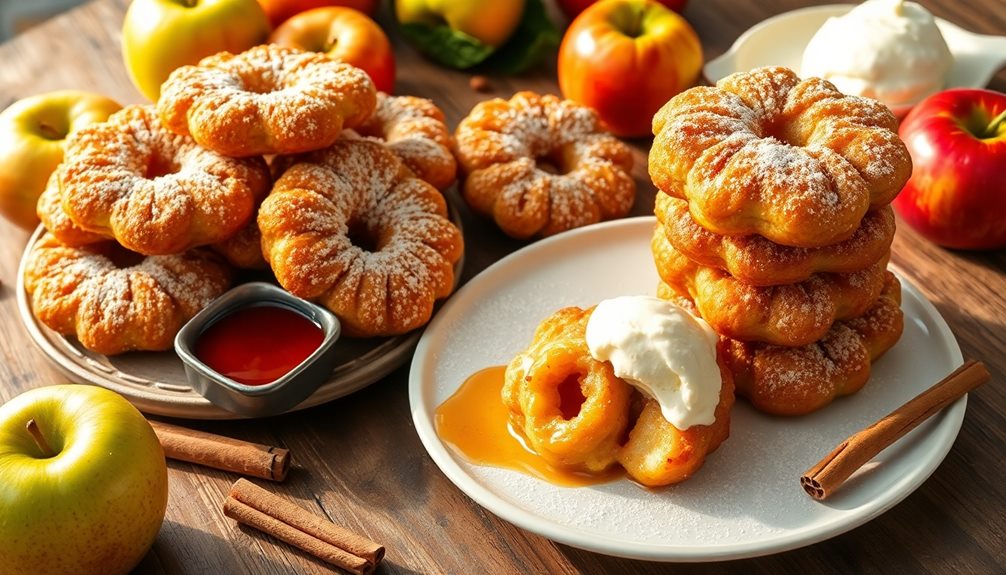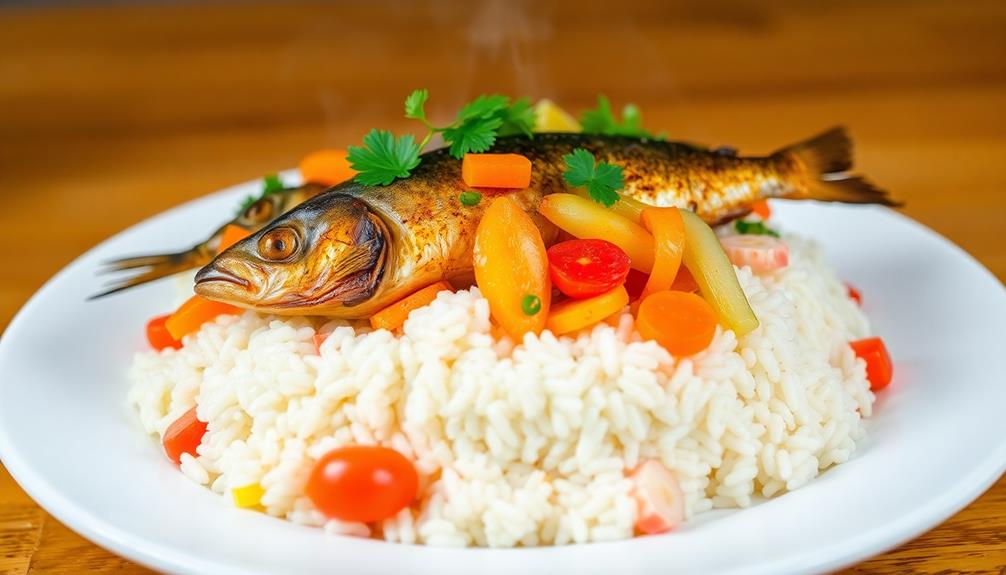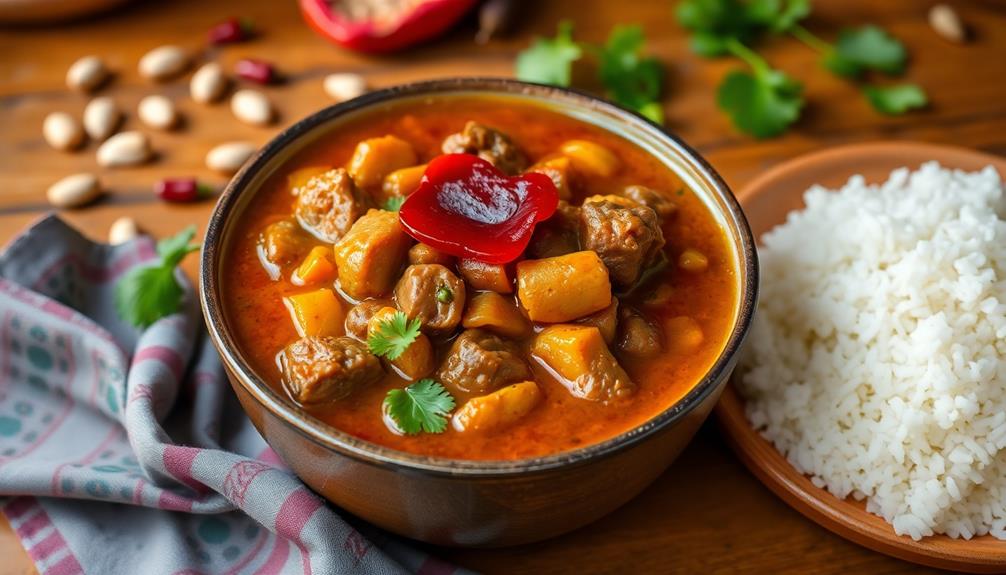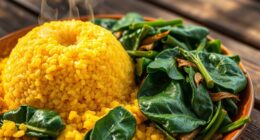Tuwo Shinkafa, a beloved staple of Northern Nigeria, whisks you away to the region's vibrant culinary heritage. This mouthwatering dish combines the aroma of steamed rice with the warmth of communal gatherings, creating a symphony of flavors. Crafted with care over generations, Tuwo Shinkafa reflects the resilience and ingenuity of the Northern Nigerian people. Served during special occasions like weddings and festivals, it symbolizes joy and connection. The meticulous cooking process, using local ingredients and traditional methods, ensures authenticity. Tuwo Shinkafa's comforting texture and rich flavor leave a lasting impression, inviting you to further explore the depths of Northern Nigerian cuisine.
Key Takeaways
- Tuwo Shinkafa is a traditional dish from Northern Nigeria, reflecting the region's cultural heritage and community traditions.
- The dish is made by soaking, grinding, and cooking rice into a smooth, fluffy paste, which is then shaped into round balls.
- Tuwo Shinkafa is often served with various stews and sauces, offering a unique and comforting flavor profile.
- Preparation of Tuwo Shinkafa involves careful attention to detail, including continuous stirring during cooking to achieve the desired texture.
- Tuwo Shinkafa serves as a gateway to exploring Northern Nigerian cuisine, fostering cultural exchange and appreciation for traditional culinary practices.
History

Tuwo Shinkafa's origins can be traced back to the rich culinary traditions of Northern Nigeria. For centuries, this beloved dish has been a staple in the region, reflecting the local culture and ingredients.
Traditionally, it's made from steamed and pounded rice, creating a fluffy, pillowy texture that's simply irresistible.
The process of making Tuwo Shinkafa is a labor of love. First, the rice is carefully selected and soaked, then steamed until perfectly cooked.
Next, it's pounded and kneaded by hand, a technique passed down through generations. This attention to detail ensures the final product is smooth, consistent, and packed with flavor.
Tuwo Shinkafa is often enjoyed during special occasions, such as weddings, festivals, and family gatherings.
It's commonly served with a variety of delectable stews and sauces, each offering a unique taste experience.
Whether you're a seasoned Tuwo Shinkafa enthusiast or a newcomer to this culinary delight, it's a dish that's sure to leave you craving more.
Recipe
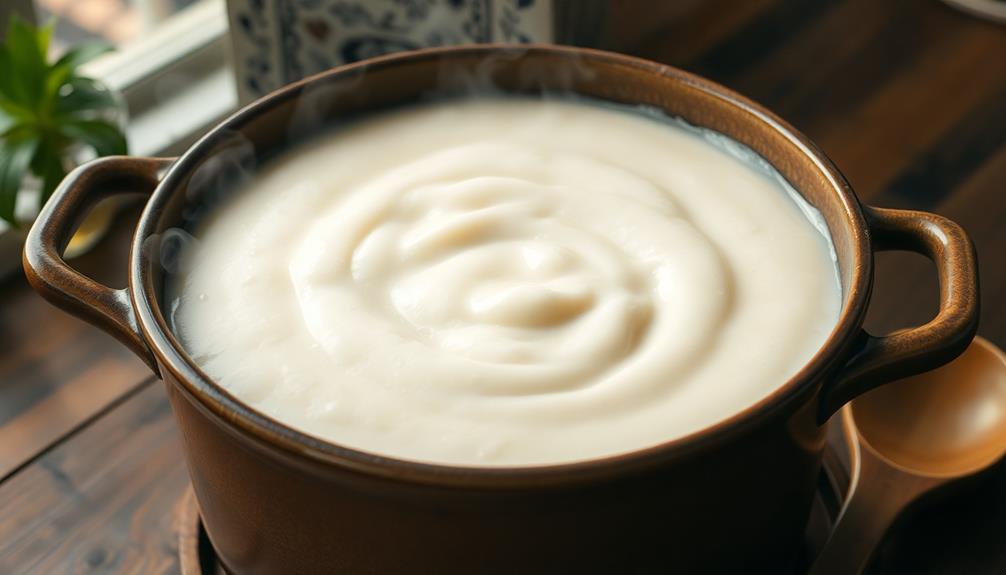
Tuwo Shinkafa is a traditional staple dish from Northern Nigeria. It's a thick, soothing porridge made from rice flour that's a beloved comfort food in the region. The dish is often served as a side or as the main course, accompanied by various stews and sauces.
Preparing Tuwo Shinkafa requires a bit of patience and technique, but the end result is a nourishing and satisfying meal. The process involves carefully cooking the rice flour to achieve the desired creamy and smooth texture.
Ingredients:
- 2 cups rice flour
- 6 cups water
- 1 teaspoon salt
Instructions:
Bring the water to a boil in a large pot. Gradually whisk in the rice flour, stirring continuously to prevent lumps from forming.
Reduce the heat to low and continue to cook, stirring frequently, for about 15-20 minutes until the mixture thickens to a smooth, porridge-like consistency. Add salt and stir to combine. Serve hot, accompanied by your choice of stew or sauce.
Tips:
When cooking Tuwo Shinkafa, it's important to add the rice flour gradually and stir continuously to ensure a lump-free texture.
The porridge should be cooked at a low heat to allow the flour to fully hydrate and reach the desired thickness. If the mixture becomes too thick, you can add a bit of hot water to thin it out.
Tuwo Shinkafa is best enjoyed freshly made, but it can also be reheated if needed.
Cooking Steps
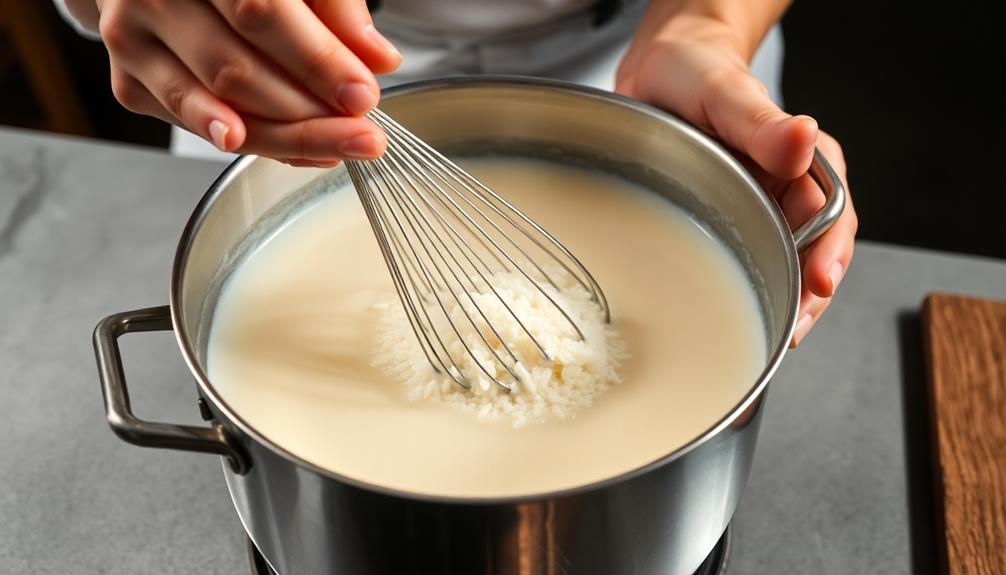
First, you'll want to soak the rice in water overnight.
Drain it well, then grind the soaked rice into a smooth batter.
Next, heat and stir the ground rice until it thickens into a soft, doughy consistency.
Step 1. Soak Rice in Water Overnight
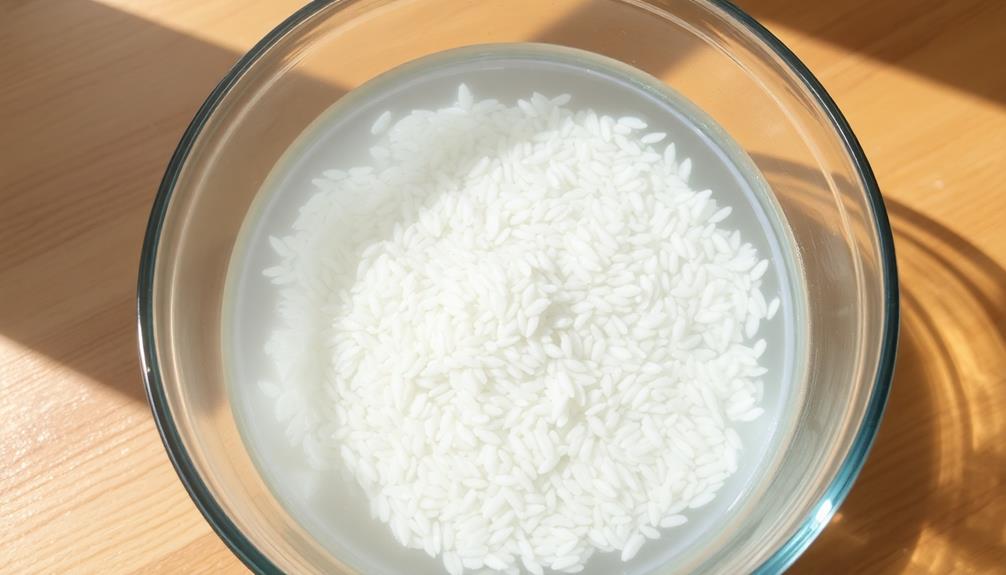
The overnight rice-soaking process is a crucial initial step in crafting the beloved Tuwo Shinkafa.
You'll want to start by rinsing the rice thoroughly, removing any impurities. Then, transfer the rice to a large bowl and cover it completely with clean water. Let it soak overnight, or for at least 8 hours. This step softens the grains, making them easier to grind into a smooth, lump-free batter.
In the morning, you'll notice the rice has absorbed the water, swelling to a plump, fluffy texture.
Drain the soaked rice, discarding the water. Now, you're ready to move on to the next step – grinding the rice into a fine paste. This ensures your Tuwo Shinkafa will have that signature silky-smooth consistency that Northern Nigerians adore.
Get ready to savor the delicious flavors and comforting aromas of this beloved traditional dish!
Step 2. Drain and Grind the Soaked Rice
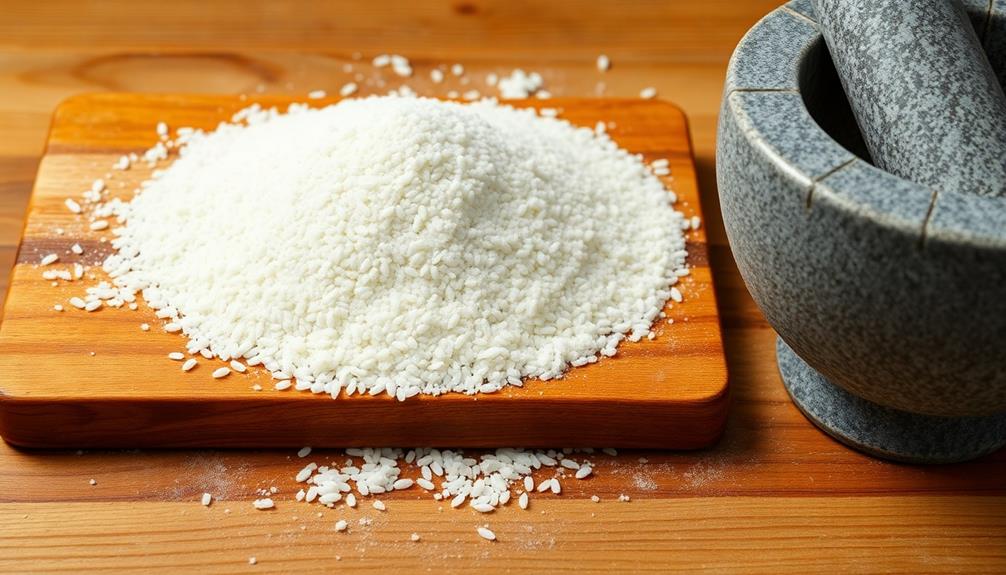
After draining the soaked rice, you're ready to grind it into a fine paste. This step is crucial for achieving the smooth, creamy texture that makes Tuwo Shinkafa so special.
Grab your mortar and pestle or a high-powered blender, and get to work!
Start by pouring the drained rice into the mortar or blender. Slowly add small amounts of water, just enough to help the rice break down into a smooth, lump-free consistency.
Be patient and take your time – the goal is to create a silky-smooth puree, without any gritty bits.
Once the rice is fully ground, the mixture should have a thick, pudding-like texture.
Taste it and add a pinch of salt if desired, to enhance the flavors.
Now, you're ready to move on to the next step of the Tuwo Shinkafa preparation process!
Step 3. Heat and Stir the Ground Rice
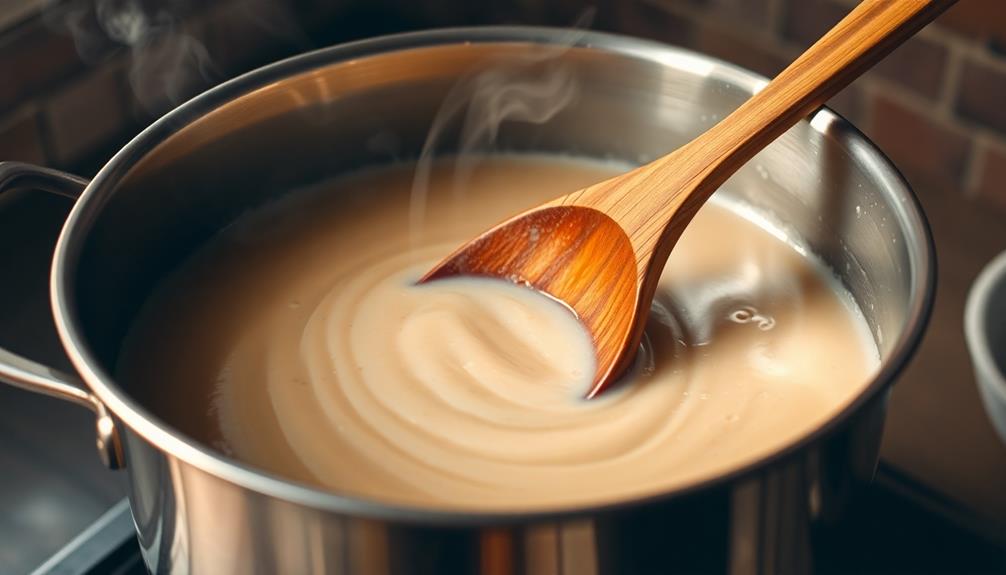
Next, place the ground rice puree into a heavy-bottomed pot and set it over medium heat. As the pot heats up, start stirring the rice continuously with a wooden spoon.
You'll want to keep a close eye on it, as the rice can thicken up quickly.
Stir, stir, stir! The rice should start to come together into a smooth, velvety mound. Don't be afraid to put some elbow grease into it – the more you stir, the better the texture will be.
As the rice cooks, you'll notice it becoming thicker and more cohesive.
Keep stirring until the rice has reached your desired consistency, about 10-15 minutes. It should have a soft, porridge-like texture that's perfect for scooping and serving.
Taste it occasionally to check the doneness. Once it's ready, remove the pot from the heat and get ready to enjoy this northern Nigerian delicacy!
Step 4. Shape Into Balls
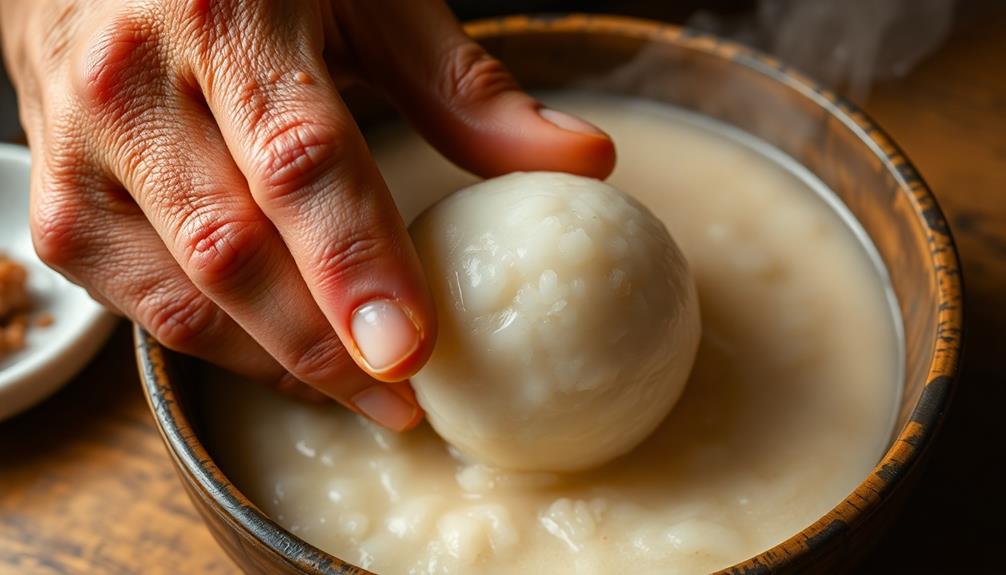
With the tuwo shinkafa now at the desired consistency, you can begin shaping it into balls. Grab a palm-sized portion of the steaming hot dough and gently roll it between your palms, forming a smooth, round ball. Be careful not to squeeze too hard, as the delicate texture can easily be disrupted.
As you work, envision the joyful faces of your family and friends eagerly awaiting these tasty tuwo shinkafa balls. Imagine their delight as you present the platter, each sphere a perfect golden-brown. The anticipation will be palpable, their mouths watering in anticipation of sinking their teeth into the soft, fluffy interior.
Continue shaping the tuwo shinkafa, creating a uniform batch that will ensure every bite is as satisfying as the last. With each ball you form, let your excitement build, knowing that you're about to share a beloved Northern Nigerian tradition with those you love.
Step 5. Serve Warm With Stew or Soup
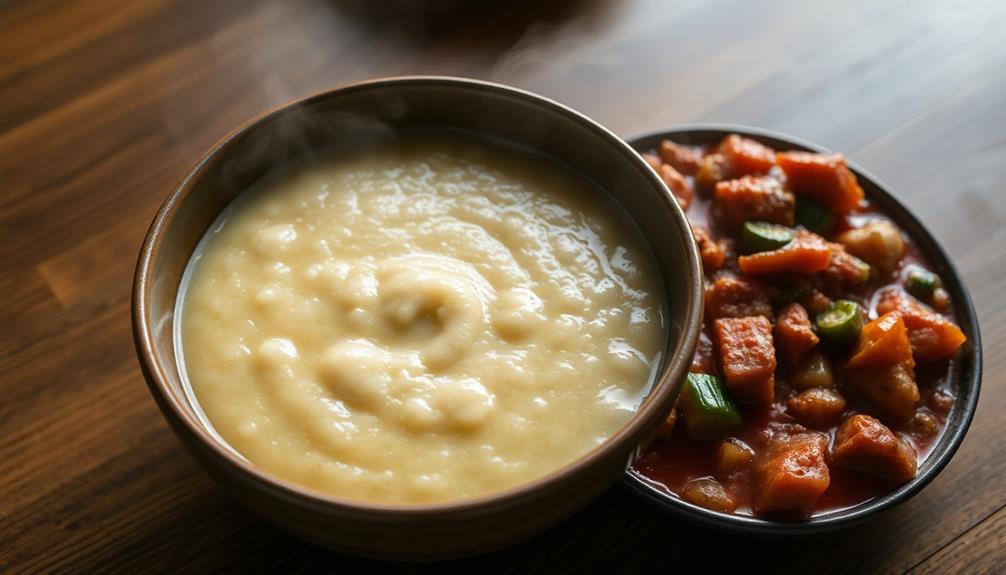
Serve the freshly shaped tuwo shinkafa balls warm alongside your preferred stew or soup. This classic pairing is a beloved tradition in Northern Nigeria, bringing families and communities together.
The soft, fluffy texture of the tuwo shinkafa complements the rich, flavorful stew or hearty soup perfectly. Ladle the hot stew or soup over the tuwo shinkafa balls, allowing the flavors to mingle. The combination of the comforting warmth and the delightful aromas will tantalize your senses.
Encourage everyone to dig in and enjoy the satisfying meal. For a festive gathering, arrange the tuwo shinkafa balls on a platter and surround them with various stew or soup options. This allows your guests to customize their dish to their liking.
Encourage them to experiment and discover their favorite pairings. Whether it's a weeknight dinner or a special occasion, serving tuwo shinkafa with stew or soup is a delightful way to savor the rich culinary heritage of Northern Nigeria.
Final Thoughts
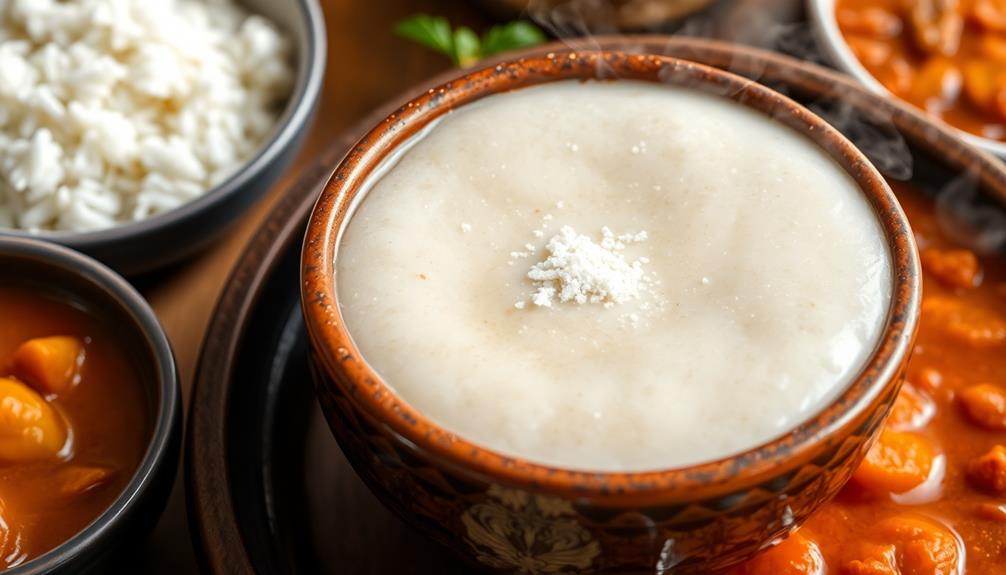
Tuwo shinkafa has long been a staple in Northern Nigeria, cherished for its comforting texture and rich flavor. As you savor this delectable dish, you can't help but feel a sense of nostalgia and connection to the vibrant culture that birthed it.
Whether enjoyed at a family gathering or a community celebration, tuwo shinkafa has the power to bring people together, sharing in the warmth and joy that radiates from every bite.
Beyond its gastronomic delights, this staple holds a deeper significance. It represents the resilience and ingenuity of the Northern Nigerian people, who've thoughtfully crafted and perfected this recipe over generations.
Each step, from the careful selection of ingredients to the meticulous preparation, is imbued with tradition and a deep appreciation for the land that nourishes them.
As you bid farewell to this culinary journey, remember that tuwo shinkafa is more than just a dish – it's a testament to the rich tapestry of Northern Nigerian heritage, a flavor that will linger long after the last morsel has been savored.
Frequently Asked Questions
What Is the Nutritional Value of Tuwo Shinkafa?
Tuwo shinkafa is a nutritious dish packed with carbohydrates, providing sustained energy. It's also a good source of fiber, which supports digestive health. Don't forget the essential vitamins and minerals it contains, making it a well-rounded meal option.
How Long Can Tuwo Shinkafa Be Stored?
You can store tuwo shinkafa for up to 3 days in the fridge. However, it's best consumed fresh as it'll start to dry out and lose its soft, fluffy texture over time. Enjoy it at its prime!
What Are the Traditional Serving Accompaniments for Tuwo Shinkafa?
Traditionally, tuwo shinkafa is often served with various savory stews or soups, like miyan kuka or miyan taushe. You can also enjoy it with grilled or fried fish, meat, or vegetables for a complete and flavorful meal.
Are There Any Vegetarian or Gluten-Free Variations of Tuwo Shinkafa?
Yes, there are vegetarian and gluten-free variations of tuwo shinkafa. You can make it with alternative flours, like millet or sorghum, and serve it with vegetable stews or soups instead of the traditional meat-based accompaniments.
Does Tuwo Shinkafa Have Any Cultural Significance in Northern Nigeria?
Tuwo shinkafa holds deep cultural significance in Northern Nigeria. It's a staple dish that's often served at important events, reflecting the region's heritage and traditions. Its preparation and consumption are woven into the fabric of Northern Nigerian culture.
